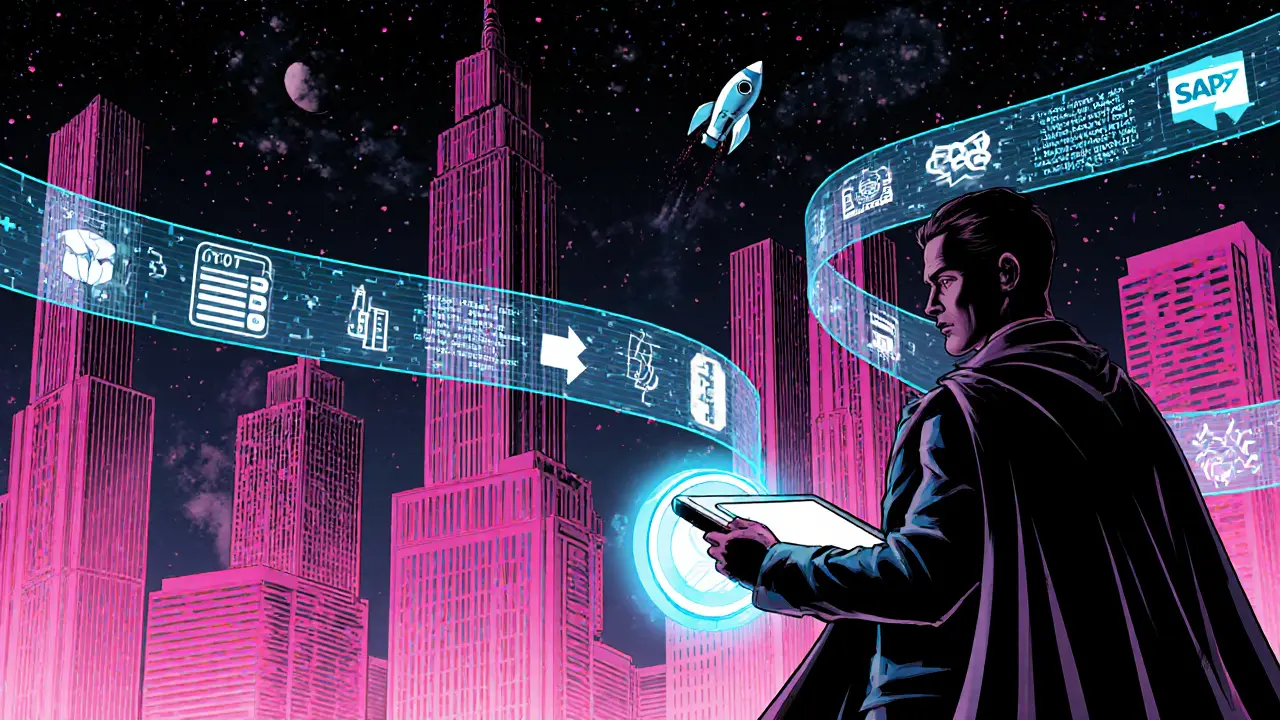BaaS Platform Comparison Tool
Compare BaaS Providers
Select your requirements to find the best blockchain platform for your enterprise needs.
Enterprises are finally unlocking blockchain’s potential without wrestling with massive infrastructure headaches, thanks to the rise of BaaS. Blockchain-as-a-Service (BaaS) delivers ready‑to‑use blockchain networks from the cloud, letting companies focus on business logic instead of node provisioning, consensus tuning, or raw security patches.
What Blockchain-as-a-Service Actually Is
Blockchain-as-a-Service (BaaS) is a cloud‑based service model that provides developers with managed blockchain platforms, smart‑contract tooling, and network governance without the need to own the underlying hardware. Think of it as a subscription that hands you the ledger, the consensus engine, and the APIs while the provider takes care of uptime, scaling, and regulatory‑grade security.
Why Enterprises Choose BaaS Over In‑House Development
- Speed to market: Deploy a functional network in days, not months.
- Cost predictability: Pay‑per‑use pricing replaces cap‑ex heavy hardware buys.
- Security & compliance: Providers embed GDPR, SOX, and industry‑specific controls.
- Scalability: Auto‑scale transaction throughput as business volume spikes.
- Expert support: Access to platform engineers who specialize in blockchain ops.
Key BaaS Platforms Shaping the Market
Three cloud giants dominate the space, each tailoring services to different enterprise priorities.
- Microsoft Azure Blockchain Service is a fully managed platform that streamlines Ethereum‑based development, offering integrated DevOps pipelines and Azure Active Directory identity management.
- Alibaba Cloud Blockchain Service focuses on stability and multi‑protocol support, including Hyperledger Fabric and Ant Blockchain, with built‑in data encryption for Asian markets.
- Quorum (originated by JPMorgan Chase) is an open‑source, permissioned Ethereum fork that emphasizes privacy, high‑throughput, and enterprise‑grade smart‑contract auditing.

Feature‑by‑Feature Comparison
| Platform | Supported Protocols | Key Strengths | Typical Use Cases |
|---|---|---|---|
| Microsoft Azure Blockchain Service | Ethereum, ERC‑20, ERC‑721 | Integrated dev tools, Azure AD security, global data centers | Tokenization, supply‑chain traceability, fintech apps |
| Alibaba Cloud Blockchain Service | Hyperledger Fabric, Ant Blockchain, Quorum | Multi‑protocol flexibility, Asian regulatory compliance, low‑latency network | Cross‑border trade, government record‑keeping, IoT logistics |
| Quorum (JPMorgan Chase) | Ethereum‑compatible (permissioned) | High throughput, private transaction pools, extensive customizability | Inter‑bank settlement, confidential asset trading, corporate governance |
Implementing BaaS: A Practical Roadmap
- Define the business problem - e.g., need for immutable audit trails in supply chain.
- Select a platform that aligns with required protocols and compliance needs.
- Design network topology: permissioned vs. permissionless, number of validator nodes, and identity management.
- Develop and test smart contracts in a sandbox environment provided by the BaaS.
- Integrate with existing ERP/CRM systems using provided APIs or SDKs.
- Run a pilot with a limited set of participants to validate performance and governance.
- Scale to production, monitor metrics, and adjust access controls as regulatory frameworks evolve.

Real‑World Case Studies
Renault partnered with IBM to launch an automotive‑industry blockchain that tracks component provenance across 6,000+ regulatory standards. The solution cut non‑compliance costs by 50% and trimmed quality‑issue expenses by 10%.
In the logistics arena, HCLTech deployed a three‑node BaaS network for a global retailer, enabling real‑time visibility of shipments and automated customs documentation.
Financial institutions are leveraging Quorum to settle inter‑bank payments within seconds, bypassing legacy SWIFT delays while preserving transaction confidentiality.
Future Trends Shaping BaaS
Analysts forecast the BaaS market to reach $120.70 billion by 2031, driven by three emerging forces:
- Privacy‑enhancing tech such as zero‑knowledge proofs that will let enterprises prove compliance without exposing raw data.
- AI‑assisted smart‑contract generation, reducing developer effort further.
- Deeper integration hooks with ERP suites like SAP and Oracle, making blockchain a native extension of core business software.
Bottom Line: BaaS as the Enterprise Enabler
By abstracting the heavy‑lifting of blockchain infrastructure, BaaS lets companies experiment, iterate, and scale with far less risk. Whether you’re a supply‑chain manager, a fintech startup, or a healthcare provider, the pay‑as‑you‑go model reduces barriers and accelerates value capture.
What is the difference between a public blockchain and a BaaS‑based enterprise network?
Public blockchains are open to anyone and rely on token‑based incentives for security. BaaS‑based enterprise networks are permissioned, meaning only vetted participants can join, and security is managed by the cloud provider under corporate compliance rules.
Can I migrate an existing on‑premise blockchain to a BaaS platform?
Yes. Most providers offer migration tools and APIs that let you export ledger data, re‑create smart contracts, and redeploy the network on their managed infrastructure with minimal downtime.
How does BaaS handle regulatory compliance like GDPR?
Providers embed data‑residency options, encryption‑at‑rest, and audit‑logging capabilities that satisfy GDPR, SOX, and industry‑specific mandates. You still need to configure access controls to match your internal policies.
Is BaaS cost‑effective for small to medium businesses?
Because pricing is consumption‑based, SMEs pay only for the transactions and storage they actually use, avoiding large upfront hardware costs and staff overhead.
What technical skills are still required when using BaaS?
Teams need basic cloud‑service knowledge, an understanding of the chosen blockchain protocol, and the ability to write or audit smart contracts. The heavy lift of node management and network ops is offloaded to the provider.


mike ballard
October 22, 2025 AT 02:25Blockchain-as-a-Service (BaaS) is basically the SaaS of the distributed ledger world 😎. You get the hyper‑secure consensus engine, the cryptographic primitives, and the API gateway all wrapped in a managed container, so you can focus on writing Solidity or chaincode instead of patching node VMs. The cloud provider also throws in auto‑scaling, DDoS protection, and compliance certifications out of the box. In practice, it cuts the time‑to‑market from months to days, and the cap‑ex becomes an OPEX line item. No wonder enterprises are jumping on the bandwagon.
Molly van der Schee
October 26, 2025 AT 09:49Seeing how BaaS abstracts away the heavy lifting really opens doors for teams that were once hesitant to touch blockchain. It lets business units experiment with immutable audit trails without getting bogged down in infra headaches.
john price
October 30, 2025 AT 18:13Look, the hype train isnt gonna stop just because some cloud vendor slaps a UI on it. You still need solid smart‑contract design or you’ll end up with a brittle system that crashes on the first load.
Ty Hoffer Houston
November 4, 2025 AT 02:37I’ve actually spun up an Azure Blockchain instance for a supply‑chain pilot, and the integration with Azure AD made onboarding partners a breeze.
Ryan Steck
November 8, 2025 AT 11:01Sure, but remember that every “managed” service is a backdoor for the big tech guys. They’ll log every transaction and could hand it over under vague “compliance” requests.
James Williams, III
November 12, 2025 AT 19:25From a technical standpoint, the biggest advantage of BaaS is the native support for chaincode lifecycle management – you can version your contracts, run automated tests in a sandbox, and promote to prod with a single click.
Amy Kember
November 17, 2025 AT 03:49But does that sandbox truly isolate gas consumption spikes? Variable costs can still surprise cash‑flow budgets.
Anna Kammerer
November 21, 2025 AT 12:13Oh yeah, because everyone loves surprise bills after a DDoS‑style token mint marathon. 🤦♀️
Mike GLENN
November 25, 2025 AT 20:37When you look at the broader enterprise trends, BaaS isn’t just a convenience layer, it’s a strategic catalyst that reshapes how IT departments allocate resources. Traditionally, a blockchain project required a dedicated infrastructure team, hardware procurement cycles, and a deep bench of Ops engineers versed in consensus algorithms. By moving that burden to a managed service, companies can reassign those engineers to focus on business logic, data integration, and compliance automation. The pay‑as‑you‑go pricing model also aligns costs with actual transaction volume, which means that a seasonal spike in supply‑chain activity won’t balloon the budget unexpectedly. Moreover, the built‑in monitoring dashboards give real‑time visibility into block latency, node health, and smart‑contract execution failures, turning what used to be black‑box debugging into a proactive operation. Security is another major win: providers embed hardware‑rooted attestation, encryption‑at‑rest, and regular patch cycles that most in‑house teams simply can’t match. Regulatory compliance becomes easier too, because many BaaS platforms certify against GDPR, SOX, and industry‑specific standards out of the box. Integration points with ERP systems like SAP and Oracle are also maturing, allowing ledger entries to trigger downstream workflows without custom middleware. From a developer perspective, the SDKs and CLI tools abstract away low‑level networking, so you can write chaincode in familiar languages such as Java, Go, or even JavaScript. This lowers the barrier for talent acquisition, as you no longer need to hunt for niche blockchain ops specialists. The ecosystem effect is also noticeable: as more vendors offer BaaS, a marketplace of pre‑validated templates and governance modules is emerging, further shortening time‑to‑value. Of course, it’s not a silver bullet-organizations still need to design proper data models, understand the immutability constraints, and plan for on‑chain governance. But the net effect is a dramatically faster innovation cycle, where proof‑of‑concepts can graduate to production in weeks rather than quarters. In short, BaaS turns blockchain from a niche IT experiment into a mainstream enterprise capability.
BRIAN NDUNG'U
November 30, 2025 AT 05:01Thank you for the comprehensive overview; the points regarding cost alignment and regulatory integration are especially salient for large enterprises seeking predictable budgeting.
Donnie Bolena
December 4, 2025 AT 13:25Wow, the market outlook of $120B by 2031 is mind‑blowing!! 🚀 This really shows how quickly blockchain is moving from niche experiments to core business infrastructure!!!
Elizabeth Chatwood
December 8, 2025 AT 21:49Looks like we’re in for a wild ride ahead
Tom Grimes
December 13, 2025 AT 06:13Honestly, I think most of the hype around BaaS is just a way for big cloud firms to get more of our money while pretending they’re helping us innovate. They talk about “security” and “compliance” but in reality they’re just adding another layer you have to trust. If something goes wrong, you end up blaming the provider, yet you have no visibility into the underlying nodes. It feels like we’re handing over control of critical business processes to a black box. At the end of the day, we should ask ourselves whether the convenience is worth the loss of direct oversight.